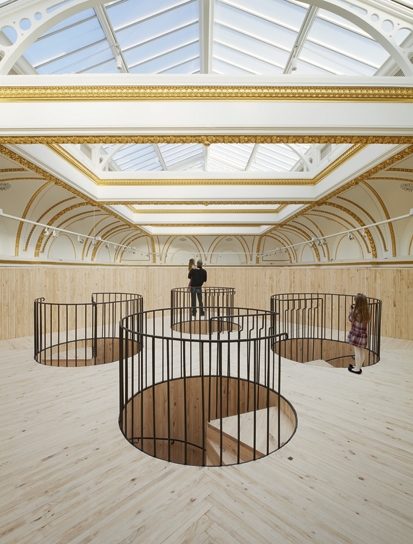Curtain walls, dreaming spires, crockets, finials, cantilevers, bush-hammered concrete, vermiculated rustication, heroic steel and delicate Cosmati work are all diverse parts of the architect’s vocabulary. But while Gothic, Classical, Baroque and Modern are well-thumbed volumes in his library of style, the architect’s real language is profound and prehistoric. Or, at least, it consists of prehistoric-style labels.
So much of the ‘debate’ about architecture has been crudely adversarial with tweedy historicists, conservationists and pseudo-classicists supposedly lined up against antagonising, pitiless and chromium-plated technocrats, futurologists, social engineers and ditsy dreamers. With well-meaning intention, but ill results, the Prince of Wales set up a false opposition between stage armies of old and new.
Really, the question is more about what’s good and what’s bad. But judging good or bad is a demanding task, hence the escape into cartoonish conflicts. So the Royal Academy’s Sensing Spaces exhibition is very welcome: it gets to the essence of architecture, what’s beneath every surface, what’s beyond the details. It makes the point, with appropriate and impressive theatrical bravura, that architecture is as much about feeling as about seeing. The sense of ‘hazard and surprise’ was how Soane liked to describe a good result. Here you have it.
Since it was founded in 1768, the Royal Academy has had a curiously mixed involvement with architects. Sir William Chambers, designer of Somerset House, schmoozed George III and won royal patronage for the new Academy, but it was the painter Sir Joshua Reynolds who became its first president. There have been some distinguished architect PRAs, notably Edwin Lutyens and Hugh Casson, but, perhaps because of their practical temperaments, architects feature disproportionately often in the list of the Academy’s treasurers.
Then there is the Royal Academy’s own history of architectural exhibits. The Foster Rogers Stirling show of 1986 now seems like wince-making period narcissism (which contributed to the damaging celebrity culture from which architecture is only now emerging). Then there was Palladio, a heartless indulgence whereby art-historian curators showed off minutiae of boring, footnoted scholarship instead of explaining design principles or helping visitors appreciate their results. That’s to say, ‘academic’ in the worst sense. And last year’s Richard Rogers retrospective was all very worthy, but at the same time it was incurious, supine hagiography.
Sensing Spaces emphatically puts all of that into the past. Seven architects, most of whom you have never heard of, have been invited to fill the Academy’s cavernous, hieratic spaces with tangible dreams of space and light. Up the stairs and turn left. The first note I wrote was ‘space exploration’. Here you find a vast, rough but monumental wooden structure by the Chilean-Argentinian partnership Mauricio Pezo and Sofia von Ellrichshausen. You climb through gigantic cylindrical towers to address real and metaphorical angels. (When you get to the top, you can eyeball gilt angelic brackets on the old frieze, while at the same time feeling a little closer to Heaven.)
In another room, the Japanese architect Kengo Kuma has whittled bamboo into four-millimetre fronds in a dark, swaying inland sea. That sounds like the worst excess of public-art drivel, but when designed with a Zen-master mentality, it becomes beautiful and pacifying. Additionally, Kuma plays with changing light and crosses the final sensual frontier for designers: smell. His installation plays with the Japanese scents of hinoki and tatami.
Completely different in effect are belligerent Corbusian slabs hung from on high by Dublin’s Grafton Architects to evoke the idea of magnificent interplay. Beijing’s Li Xiaodong has made a satisfying maze that leads to a secret garden, while an African architect called Diébédo Francis Kéré has created something very pretty with found materials. The least interesting exhibits are, in a way some will find significant, by the best-known architects: Eduardo Souto de Moura and Alvaro Silva, the pair from Porto. The first introduces some precast concrete arches that I did not understand, the second has installed something yellow and pretentious in the Courtyard.
There is nothing so dismal as a fact, my PR genius friend Mark Borkowski tells me. And Sensing Spaces is about ambiguity, not data. Thus, it is not dismal at all. Of course, notions of ambiguity and the analysis of feeling bring us to philosophy, hence it is the French who, historically, have had the most to say on the ungraspable subject of architectural space. Gaston Bachelard’s La Poétique de l’Espace (1957) is the éminence grise in the Royal Academy’s rooms. Bachelard says, ‘We must listen to poets,’ adding that ‘a candlelight in a window can bring a whole street to life’. Of course it can. That most practical of men, Winston Churchill, knew this too. We shape our buildings and then our buildings shape us, he said.
Of course they do. Sensing Spaces shows how much better-off we would be if we listened to poets. And let them build. It’s the best exhibition of architecture I have ever …experienced.





Comments